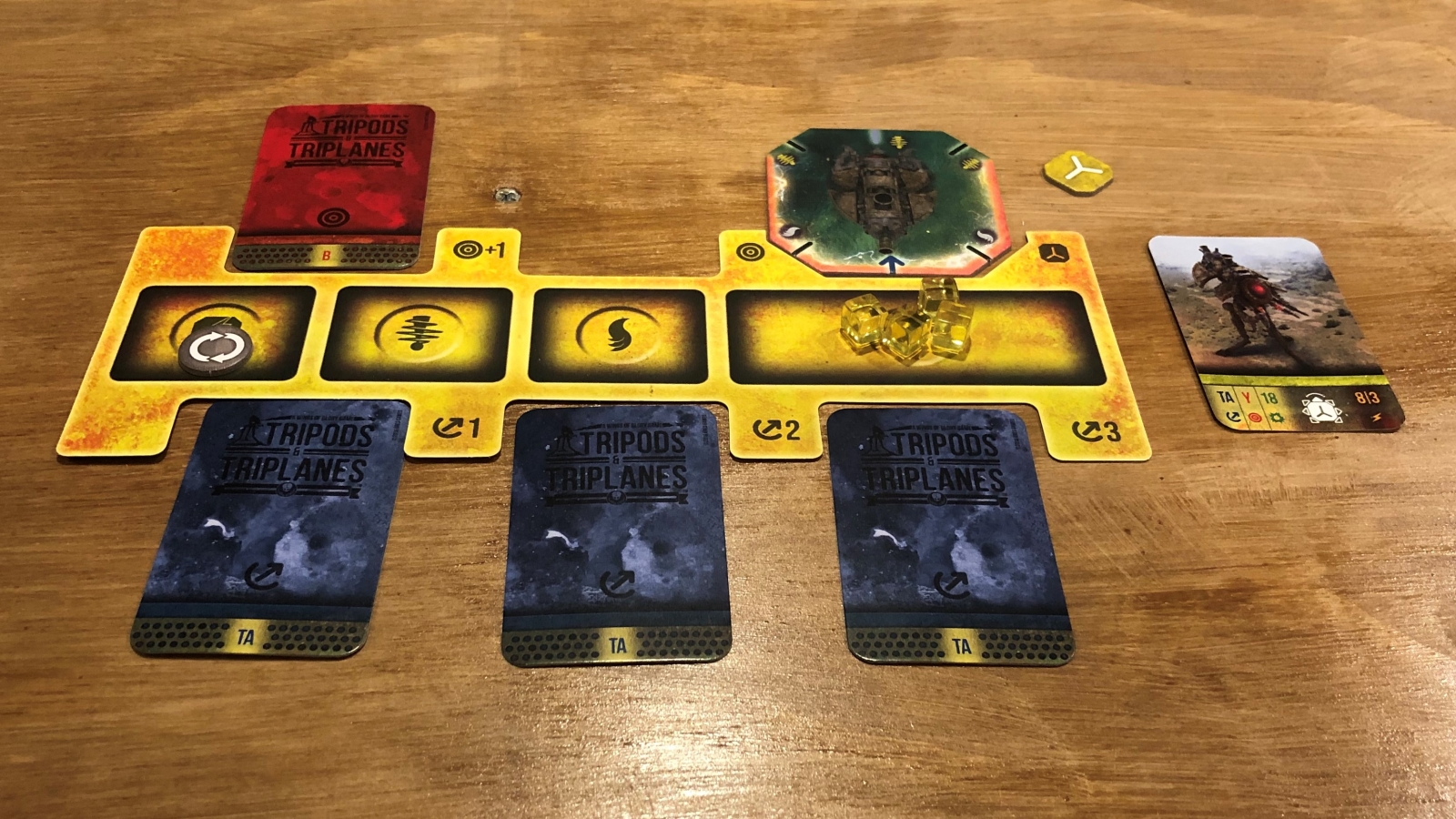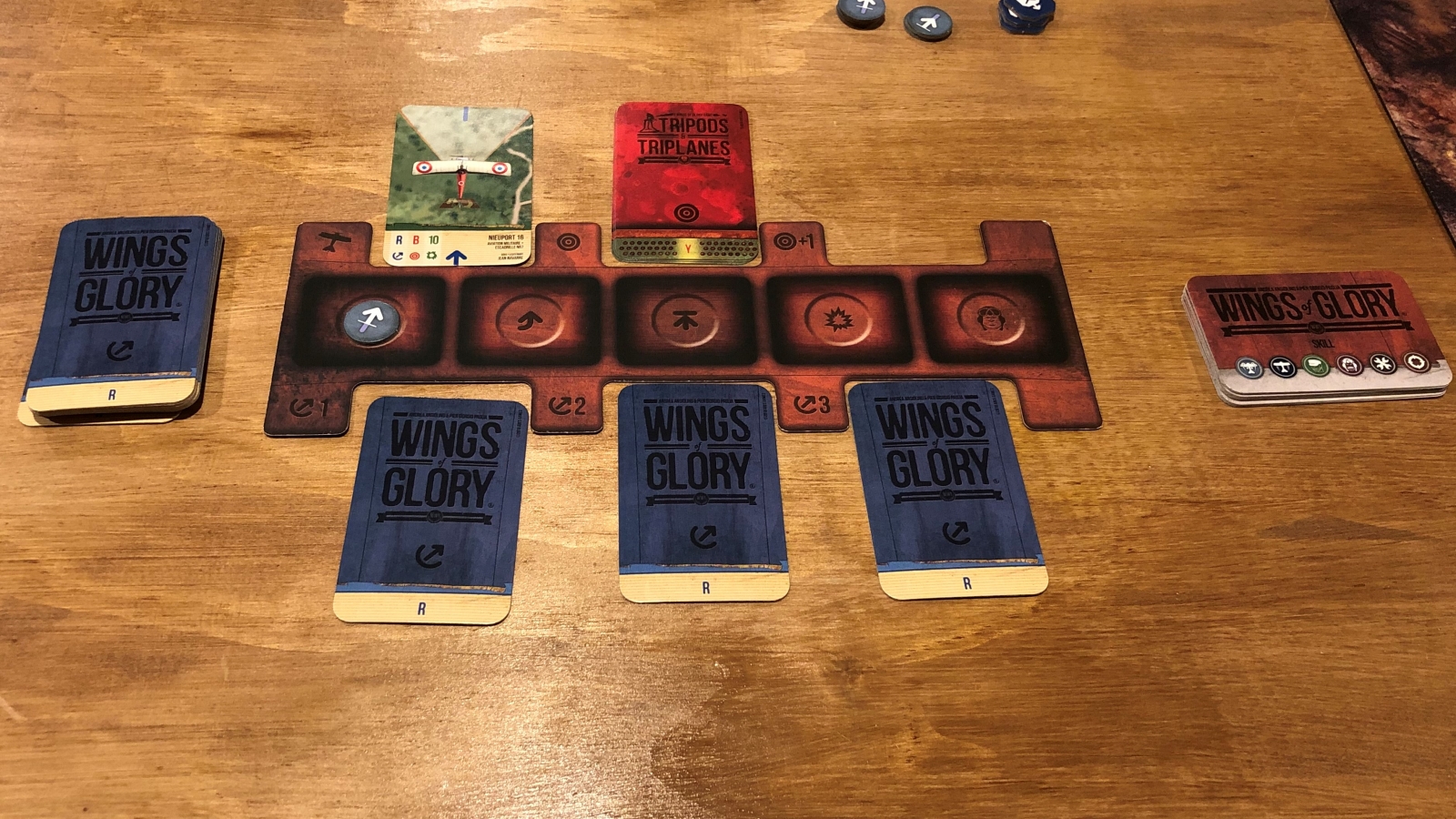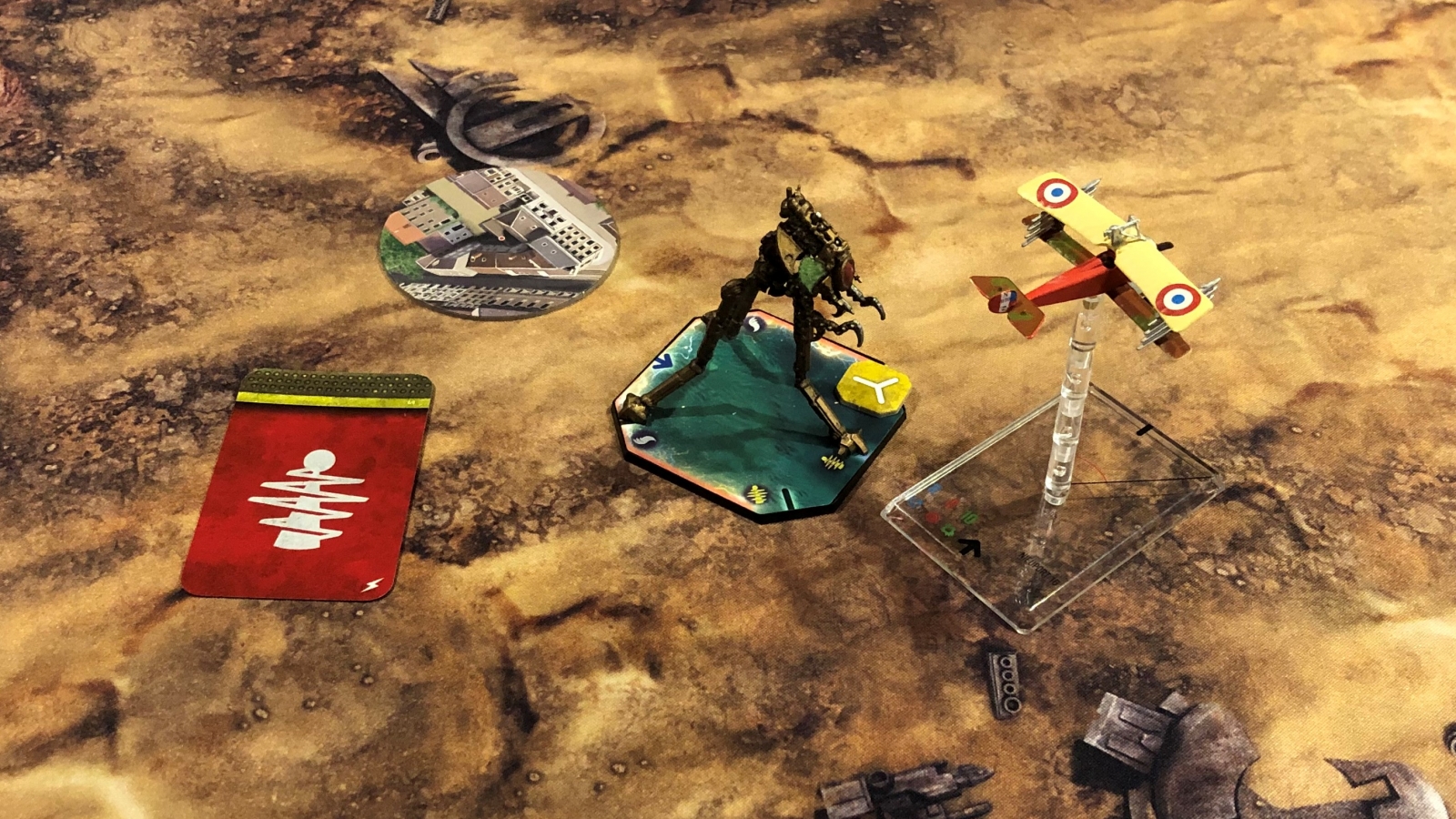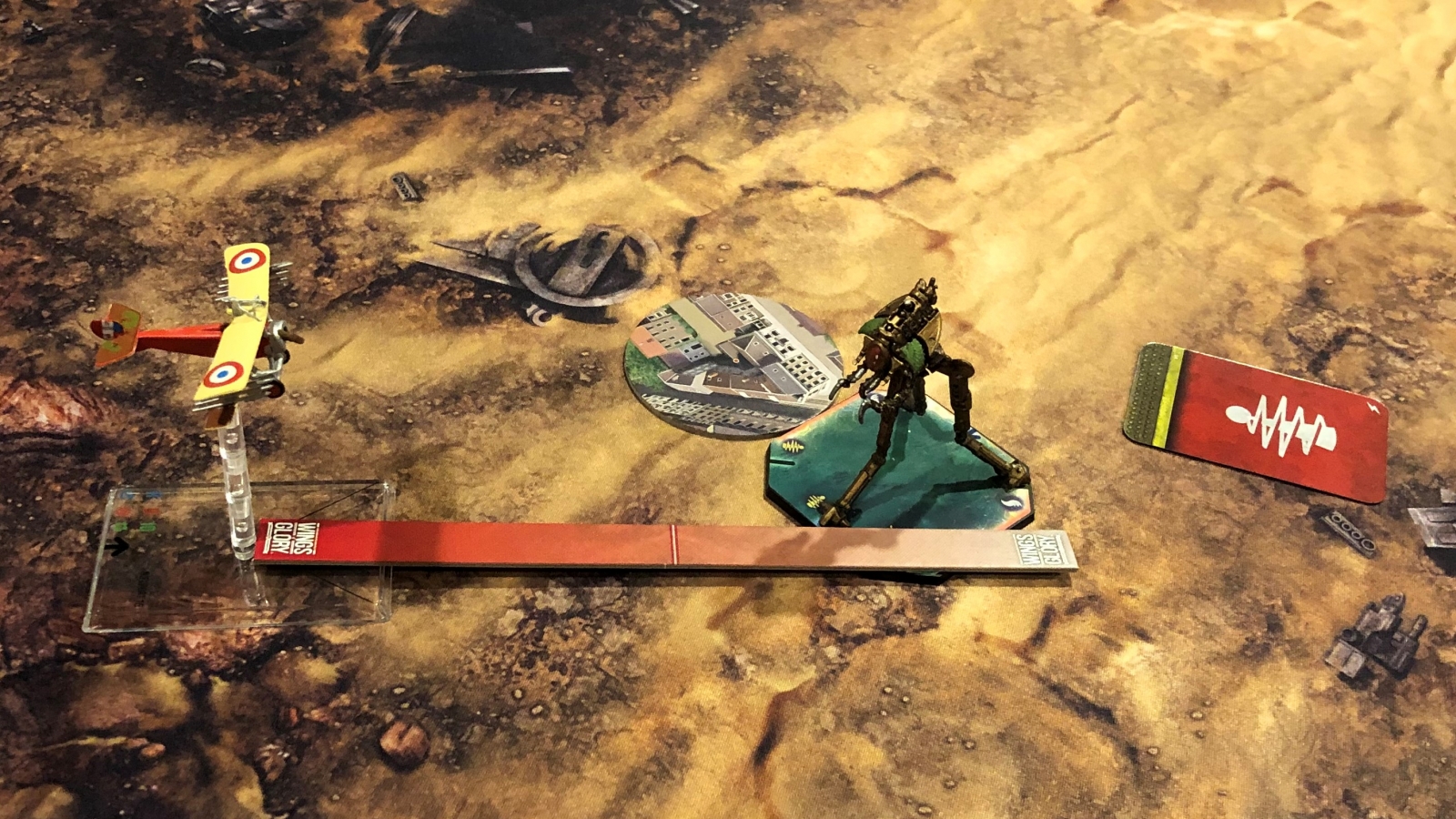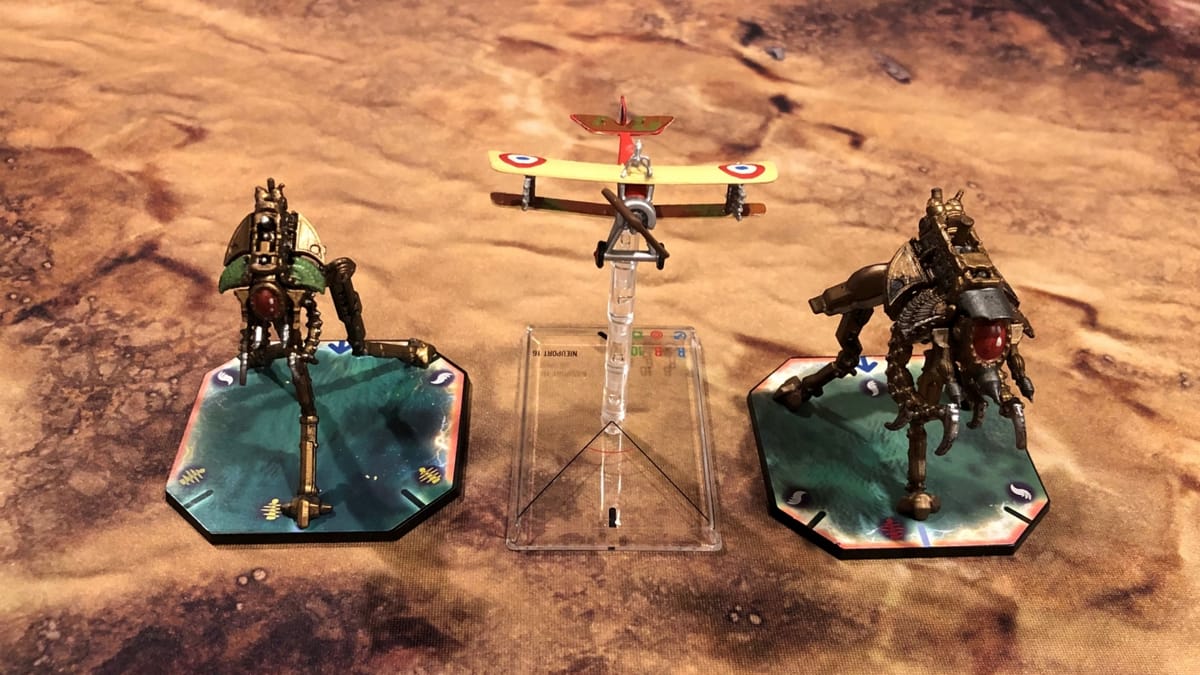
It’s 1918 and the War to End All Wars has engulfed Europe. Across the frontiers of France and Germany, soldiers on the ground endure unending, brutal stalemates of muddy trench warfare. Overhead, flying in newly invented airplanes, a new type of combatant cartwheels and careens across the embattled skies. Flying over the hellish trenches to obtain intelligence, drop bombs, and engage in dogfights, the opposing airmen are inventing aerial combat as they go. But, as the war rages on, an even newer and stranger combatant enters the fray! Aliens in tall, walking tripods with strange technology at their command arrive and instantly change the course of the war and the battlefields of Europe. Protected by mysterious energy fields and capable of firing intense rays of heat, these dangerous alien machines walk across the countryside dealing out destruction with ease. It’s up to the courageous airmen to face off against these behemoths and try to bring them down in their tracks. Suddenly, aerial combat is rewritten, interaction with an opponent on the ground is no longer just a bombing run, a strafing run, or a camera mission over enemy territory. Now, the pioneers of aerial combat must test their mettle against armored giants that can easily dish out more punishment than their fragile airplanes can take. They aren’t completely outmatched, however, the pilots have new technologies and creative uses of old ones at their fingertips to tip the balance back in their favor. The stage is set for the fight between aliens and humans!
Wings of Glory — Tripods & Triplanes is a standalone tabletop wargame that also functions as an expansion to the World War One range of Wings of Glory, Ares’ Games air-combat tabletop wargame. Tripods & Triplanes pits a player with WWI fighter aircraft from any of the factions available in the Wings of Glory game against H.G. Wells–style alien tripods that have invaded the Earth for reasons unknown. The base box provides two players everything that they need to get started, while expansions make more options available for both the alien and human sides. Since the game uses airplanes from the Wings of Glory WWI range, the human player can pull from any of the factions in that game — it seems the arrival of the aliens leads to a hasty truce between the human belligerents.
The box comes with an airplane mini, a tripod mini, some cardstock “consoles”, a pile of cards, counters, tokens, templates, and rulers, and a rulebook. The 1:144 scale, pre–painted minis are of excellent quality. The airplane is a historical French biplane called a Niueport 16, and the alien tripod is called a MK. I (Locust). The Niueport comes with a clear plastic base and three pegs that can be inserted into the base and each other to hold the mini at different heights. The Locust is glued directly to its clear base. The consoles, one style for airplanes and one style for tripods, have boxes printed on them for tokens and cutouts around the outside for slotting cards. Using the consoles, the players keep track of the maneuvers they are making, the damage they have taken and other game information. There are a ton of cards in the box, all of which are about half the size of standard playing cards. Most of the cards make up a half dozen different damage decks, the remaining cards are maneuver decks and some other tracking cards. The counters and tokens are used to track status changes for the combatants and mark objects or temporary effects on the battlefield. The range rulers are for the various weapons that are fired in the game. There is enough in the box to get brand new players started fighting battles on the tabletop right away. For those interested in expanding their inventory, there are another three dozen or so airplanes and three more tripod variants available for purchase in single packs. My review copy included a MK. II (Scarab) expansion pack, which contained a tripod on a clear base and a deck of corresponding maneuver cards.
The rulebook is laid out in a logical manner and has a smattering of fluff about the alternate history that leads up to the events that the game chronicles. It is relatively clear, logical, and reads easily. A few of the rules could use a bit more explanation, there were times that I had to re-read sections and then play through examples to really understand a concept. For instance, it wasn’t totally clear to me how the maneuver cards recycle from turn to turn, as the rules don’t explicitly describe mechanisms involved, they just tell you what to do during a turn. After fiddling with it for a bit, it became clear to me what was going on, but that aside, the basics of the game are fairly simple, especially for experienced war gamers. Each player picks a side — one flying the airplane and the other driving the tripod and they duke it out on a three foot by three foot battlefield. Like most tabletop wargames, the objective of each game is scenario driven, so players pick a scenario to run at the start of each game. The introductory scenario has the Niueport pilot trying to take a picture of the tripod to help the human generals get an idea of the threat; the tripod driver tries to destroy the biplane before it can take the picture and leave the battlefield.
Movement is handled by laying out cards from the maneuver decks onto the battlefield in front of the vehicles and using the arrows on the cards to trace out a maneuver. Each turn both players must simultaneously select three cards from their maneuver deck and lay them out face down in the order they will be executed. Each card has an arrow on it that shows the exact path the vehicle will take on the battlefield. When it’s time to execute the maneuver, the player takes the card and physically places it on the battlefield in front of their vehicle, lining up the arrow on the card with a mark on the center of the vehicle’s base. They then slide the vehicle forward along the arrow to take their vehicle through the maneuver and then remove the card. Similar movement template methods are in use in several popular games now. The main advantage gained using this method over a tape measure is that movement can be executed simultaneously, or near simultaneously, since players choose what they are doing concurrently and cannot change their movement choices after committing. This works well for air and sea combat especially, giving gameplay a feeling of simultaneous action rather than alternating actions. The downsides to the maneuver decks are the prescriptive feel of the movement (your vehicle always does the same maneuvers exactly the same way) and the limited number of options (your opponent knows you aren’t going to turn sharper than a certain angle). The tripods have some maneuver cards that allow for stopping, rotating and backing up. The airplanes, of course, always move forward some distance – no stopping in midair. With constantly moving airplanes and stopping and pivoting tripods, the game plays out as a constantly shifting contest as players maneuver their vehicles to get their enemy in range and in their firing arcs.
Once an airplane or tripod is in range and in the firing arc of a weapon, damage cards are dealt – no rolling of dice or heavy calculations. When the airplane succeeds at maneuvering a vehicle into its firing arc and in range, damage cards are simply taken off the top of the appropriate deck and handed to the player of the damaged vehicle (two cards for short range and one card for long range). Tripod players must maneuver the airplane into their firing arc and range and choose to fire their weapon as an action. Players review the damage cards they receive and keep track of the total damage their vehicle has taken, then they place the damage cards face down next to their vehicle’s console, keeping track of the damage in secret. As an exception to this secret tracking, when the tripod player hits an airplane at close range, the first card is drawn face up and if it is a zero, it is discarded and another card is drawn face down. Players can never be sure of exactly how close their opponent’s vehicles are to destruction. In fact, the amount of damage represented by the cards starts at zero and goes up from there, so you might not actually damage your opponent at all if the cards they get in an attack are all zeros! On the other hand, a particularly high set of cards at once can destroy an enemy in one-shot. The number of zero damage and low damage cards in the decks makes most shots mildly damaging though. Each weapon on a vehicle uses a specific numbered damage deck that represents the damage it deals to others and the decks have different amounts of damage and different numbers of cards. The damage cards also have icons on them that represent additional types of damage, so a damage deck is not just a pile of numbers.
The symbols on the cards include explosions, damaged circuits, battery damage, toppling the tripods, wounding pilots, jamming guns or rudders, engine damage and more. Some special damage symbols require the players to announce the problem, others are kept hidden. All of them have effects on gameplay. Not only are the special damage symbols important, but damage is also complicated by a few additional factors. For one, when an airplane hits with the same machine gun two or more phases in a row, the damage cards are tracked in an “extra damage” pile, each card in that pile that has more than zero damage on it adds one point to its total. So it benefits the human player to line up a shot and maintain that shot several phases in a row, so they’ll want to bear down on a tripod along the same vector as long as possible. The tripods have protective electrified armor on some sides of their vehicles, so machine gun bullets from the airplanes are not likely to penetrate on the protected sides, but an explosion can get through and some small number of damage cards marked with an energy symbol all of which wears down the power to the armor – so it’s not completely hopeless to fire at an armored side. The tripods have an energy supply that powers the armor which eventually will run out and the armor ceases to function. The various extra damage types affect the ability to maneuver, use weapons and damage taken by the damaged vehicle, but that’s not all the players have available to use in the fight.
There are a selection of special abilities and rules for each side to enhance game play and increase options. The airplane can have an ace pilot – supplied on cards with special abilities for each ace. There are also anchors and chains for tripping up the tripods, rockets for blowing them up, and cannons for shooting them up. The tripods get smoke screens that block line of sight and damage airplanes that fly through them. These additional capabilities generally make play more interesting and give players more options to consider, but each also has a drawback. For instance, cannons and smoke launchers have to be reloaded or recharged after use and rockets and cannons affect the flight performance of the airplane the turn they are used. Terrain can also be added to play in the form of special illustrated terrain tokens that lay on the battlefield and represent hazards the tripod has to deal with like trenches, ponds, and woods. There are also tokens to represent objectives (various types of buildings), which the tripods can use to increase their recharge rate, but also serve as goals in different scenarios.
On the table, the game plays smoothly once players get the sequence of events down. The airplanes maneuver and traverse the battlespace like airplanes, and the tripods move like they are walking around. It takes some time to get a good feel for the various maneuver decks, and to really get a feel for what the various vehicles can do. Until players are familiar with their vehicles, combat can be clunky and frustrating. Since hitting with the weapons requires the opponent to be within a certain distance and firing arc and both players are selecting their maneuvers simultaneously, there are a lot of missed shots and flybys. Leaving the battlespace concedes the fight, so maneuvering close to the edge is also challenging and risky for new players (a little less so for experienced players). There are six scenarios in the rule book to get players started, but only one is playable with the contents of the starter box, all the rest require expansion packs (more tripods and airplanes). Playing the alien side through multiple scenarios looks to be more interesting than the human side, because the goals in the various scenarios are varied for the alien, but not so much for the human. While the learning scenario has the alien trying to destroy the airplane and the human just taking a picture and scooting, for the remaining scenarios it’s reversed: the alien player has objectives related to interacting with or destroying tokens and sometimes leaving the battlefield while the human’s goal is to just destroy the tripod(s) each time. Scenarios can be modified, of course, but it can be tricky to get the balance right if you are changing the number of vehicles a side has.
I enjoyed the play in general, and playing the human side was most fun from my perspective. Getting to know the Niueport and trying to maneuver it into firing position was most interesting. Adding in the extra weapons like the anchor and chain is absolutely essential, because trying to knock down the tripod with a machine gun can be a bit tedious at times, and if you are trying to destroy it before it can achieve an objective, it might be essential to have the other weapons available. The tripod was less fun to play for me. It was challenging and a bit tedious to get the hang of the heat rays and ultimately it felt pretty random when the airplane was attackable. More practice will certainly lead to better driving, but I’m not sure I’m interested in getting there. Since the review copy came with the Scarab expansion tripod, I played it a few times. It plays differently than the Locust, it’s certainly tougher and it has a different weapon layout, but it is less maneuverable. The Niueport fared better against the Locust than the Scarab, I felt like two Nieuports might be a better match for the Scarab.
This boxed set is an expansion to an aerial combat game, so there are a few hurdles that they need to clear with respect to introducing ground–based combatants. Altitude of the aircraft relative to the tripods seems like it would play a huge role in the game. The Wings of Glory game does have rules for tracking altitude and presumably how changes in altitude impact air combat, but those rules are not included in this box. So when your Niueport flies into combat against the tripod, presumably the pilot is zooming around at the same height as the top of the tripod with no variation. Additionally, the topography, landscape, and built up areas of the ground seem like they would be impactful in the tripod’s navigation, but they are absent, except for as dictated by the tokens placed around the battlefield. So, ostensibly, all these fights appear to take place on flat or relatively flat ground. There are some building markers, but considering the rules and the way the tripods move, adding any actual 3D terrain to the battlefield would be prohibitive. For a wargame using miniatures, having ground-based 3D vehicles and flat terrain icons is a little less fun. In fact having no other ground combatants is a little weird. While it’s understandable that this is based on a game of aerial combat so there aren’t any human ground troops, the setting capitalizes on the smallest theater of war from that time period, which leads to a strange setting where monstrous aliens are walking around the battlefield unimpeded, but troops on the ground would have available the same machine guns, rockets, cannons, and tripping chains as the airplanes. I couldn’t ignore their conspicuous absence.
This expansion to Wings of Glory isn’t bad… but it is an expansion. I’m not convinced selling it as a standalone base box makes that much sense. There aren’t enough airplanes or tripods to play any scenarios in the box other than the introductory one. The airplane feels a little underpowered to take out the tripod alone, especially the Scarab, so if the alien player has an expansion and the human player does not, it’s going to be lopsided, unless you load up the human with advanced weapons and don’t give any to the alien player. While this may be nitpicky, it has bothered me since I opened the box — there should be a triplane in the box! I did some quick research and it turns out that there are hardly any triplanes in the Wings of Glory series. I understand this matches pretty well with history: there were few triplanes that saw combat in the war, biplanes and monoplanes were much more common. So, I don’t think the alliterative name was the way to go, it had me expecting to fly a triplane. It doesn’t affect gameplay in any way, but the name is just not accurate, the name could have just as easily been Tripods & Biplanes, or Aeronauts & Aliens, or even Wings of Glory: Alien Invasion!
Wings of Glory: Tripods & Triplanes
All Right
Overall, playing Tripods & Triplanes was enjoyable and challenging, both in mastering the vehicles and keeping ahead of my opponent. I think there's a lot of fun to be had flying the airplane especially, but the tripods were less interesting to me. H.G. Wells aliens mixing it up with Great War flying aces is a unique setting and the Wings of Glory game is not a bad entry for it. It definitely fits in the wheelhouse of fans of the War of the Worlds and related fiction. But, the game suffers from lack of options in the base box. Why the rules for altitude aren't included is a mystery to me, it feels like a necessary component of play, and since the rules are contained in a different expansion, I don't know what they do. As far as I can tell, the only effect altitude has is the ability to fly over smoke clouds. But, it seems like it should be more than that – airplanes operate in three dimensions and ground vehicles two, that should factor into this game. If you already play Wings of Glory World War One and you like War of the Worlds, this is right up your alley. If you like either subject well enough, this might be up your alley. Ultimately, I am more interested in the aerial combat aspect of the game and I would rather try some air to air skirmishes against the other airplanes found in the base game rather than the tripods in this expansion.
Pros
- Realistic-feeling simultaneous movement.
- Interesting setting and unique concept.
- Nice minis.
Cons
- Feels like an expansion to a more interesting aerial combat game.
- No triplane.
- No human ground forces.

